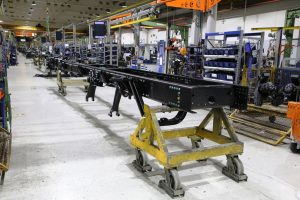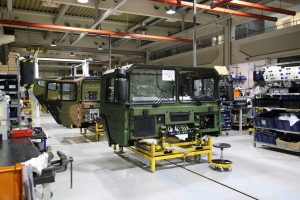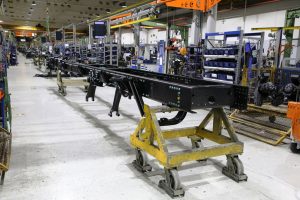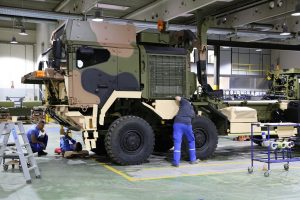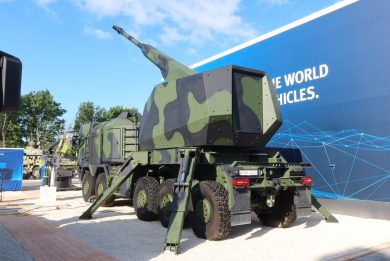RMMV boosts its truck production capacity at its Vienna-Liesing facility
To cope with the increasing demand for logistic platforms RMMV, the joint venture, headquartered in Munich, for which Rheinmetall AG holds a 51 per cent majority stake and MAN Truck & Bus SE holds the remaining 49 per cent, invested in the last years to deeply improve its facility in the Austrian capital, adding a state-of the-art logistics system and digitised manufacturing processes. This provides a considerable growth potential, allowing the joint venture to deliver in convenient times logistic trucks at a pace nearly doble to that of the past years
The facility that hosts today the Vienna branch of Rheinmetall MAN Military Vehicles, RMMV in short, was established in 1911 and since then it has been involved in automotive. After having changed name numerous times, since 2010 the Vienna-Liesing plant has become the home of RMMV Österreich GesmbH. With an overall surface of 95,000 m² of which 60,000 m² built surface, it hosts a research and development centre, which is also active on commercial trucks design, while production is now concentrated on military trucks, either militarised commercial trucks or full military trucks. The overall workforce totals 1,600 personnel, mostly blue collars, with around 200 engineers, mainly employed in R&D. EDR On-Line visited the RMMV Vienna plant back in 2018,and seven years later was once again invited to the facility, witnessing the step forward made in this period.
Since our first visit the world has changed, conflicts arising in more than one geographic area, while tension is increasing in other. While many concentrate on combat vehicles, logistics is a key element when fighting a war, and transporting fuel, ammunition, spares, and other items remains a vital task. While combat units increase in numbers, logistics must follow, hence new trucks are required; as all other defence industry segments, also the one related to trucks must prepare to increase the output. And the facility is being upgraded to be able to answer a higher demand.
The factory layout has not changed dramatically since our last visit, split in a cabin assembly line, a cooling assembly line, a main truck assembly line, a secondary truck assembly line, and all specialised areas that allow to have deliverable trucks exiting the factory every day.
In late June 2025, when EDR On-Line could visit the plant, the facility was mostly running on a single shift, from 06:00 to 14:15. Some areas made an exception, such as the painting area and some parts of the manufacturing area working on two shifts. The number of production hours per year falls between 700,000 and 1,000,000. This leaves room for a considerable production increase, providing all bottlenecks are dealt with.
In the recent past one of those bottlenecks was the preservation facility, the area where primer paint is applied, each country having its own regulations, which means that flexibility is needed to cope with the different requirements. RMMV invested in a wholly new preservation facility, which is now dimensioned considering further increase in yearly production.
The cabin assembly line has 14 Takts [1] as it was in 2018, however much has changed. Now RMMV is doing as much as possible outside the main production line, in a pre-commissioning or in a pre-assembly line, which allows to test the system and bring it in the line when it is ready, so to avoid inefficiency along the main production line. Moreover, three years ago the lean manufacturing concept was implemented, carts with all relevant components being brought at each Takt from the logistic department, reducing dead times and hence Takt time. This led to the production of 12 trucks per shift, and around one more on the special trucks line, where for example 10×10 and heavy-duty trucks are produced. One year ago, the Vienna plant has become a full paperless factory, which allows to streamline the verification process and to have at hand up to date drawings, as these are uploaded on the Production Data Management system each time a modification is done, which was not the case with paper drawings.
Screens installed along the production line also allow to check the daily situation, and all workers can now observe how the daily plan is proceeding smoothly.
This digitalisation is particularly helpful when different types of subsystems must be installed, such as the cooling system, which depends on several variables, engine type, customer, temperature scenarios, and so on, where workers might shift from one solution to another along the day.
A peculiarity of the RMMV Vienna facility is that we find a manufacturing area, which is typically used to produce parts for prototypes. However, it also acts as a buffer when a subcontractor has some issues in respecting delivery times. Even more notable is the fact that the manufacturing area allowed RMMV to continue producing, albeit at reduced pace, during the COVID pandemic, when the supply chain was heavily disrupted. In this part of the plant, we find the typical manufacturing machines, cutting, bending, drilling, etc. The RMMV plant is also certified at NATO standards for all types of welding except for armoured steel. In the light of the importance acquired by the manufacturing area in the recent past investments were done, and numerous new machineries have been acquired and put into service.
Coming to the frame assembly, the main elements must be brought to a standard temperature before assembly; an office area has been recently moved in a different building to free space to allow hosting the frame elements that are being put through the assembly process some time before this starts, a further improvement being awaited, the opening of a door duly dimensioned for allowing easy access to those cumbersome elements. One more bottleneck gone.
Many operations have been automated, for example digital screwing, which allows to precisely control the torque of any single bolt. While painting remains mostly a man-made operation, to improve the process a centralised paint delivery system has been installed; the truck data are fed in the system and the right paint is automatically delivered to spray boxes. Painting is one of the longest operations and can take over one and a half hour, which is followed by drying in a heated cabin, followed by some cooling time before being brought back to the assembly line. As it was in the preservation phase, here too the customer can require a certain type of paint and even the product provider.
Of course, quality control is performed at each stage, a reworking area being available for those trucks that do not pass tests for some minor issues, although an 80-90% of the products go straight into the delivery area, just a few requiring some minor reprocessing. The RMMV plant in Vienna is equipped with a five-axle test bench that allows testing in-house also 10×10 trucks, something that in the past was not possible, testing on public roads being expensive and time-consuming, and producing less accurate results, as conditions might vary from one test to the other. Every single truck undergoes performance tests on the bench, which usually lasts around 30 minutes, sufficient to bring lubricant at high temperature to verify any possible leakage in that condition.
Still related to quality control, the main assembly facility also hosts the Audit Hall; four to five trucks every week are picked up by quality control personnel and checked from a customer’s perspective, which allows to generate a Key Performance Indicator grade, to give a metric of the process quality. The hall would also host some specific events required by customers, such as first deliveries, as well as marketing events.
Should the customer require the installation of specific equipment, hook loader or other, this is done in a separate hall at the Vienna plant.
For 2025 RMMV plans to produce 2,600 military trucks in the Vienna plant, which will increase to 2,800 in 2026. With most bottlenecks now gone, the facility can easily increase the yearly output, this being mostly a manpower issue, the company considering a possible ramp up to over 4,000 trucks per year.
[1] Takt is the German word used to indicate a position where a part is assembled, Taktzeit being the cycle time, which is the average time between the start of production of one unit and the start of production of the next unit.
File photos (related to previous visits) by P. Valpolini


